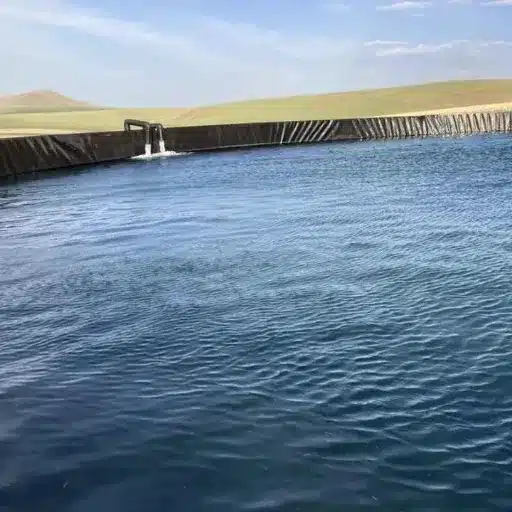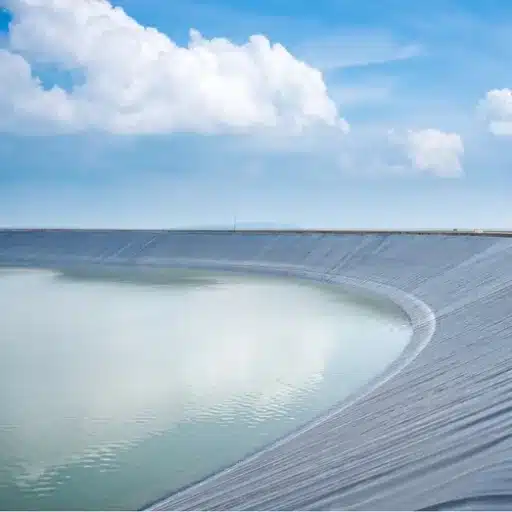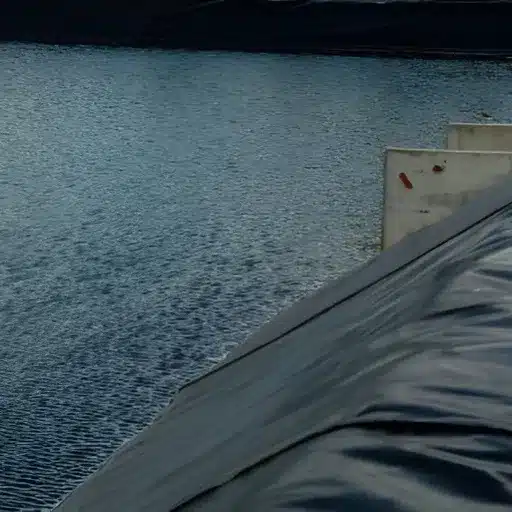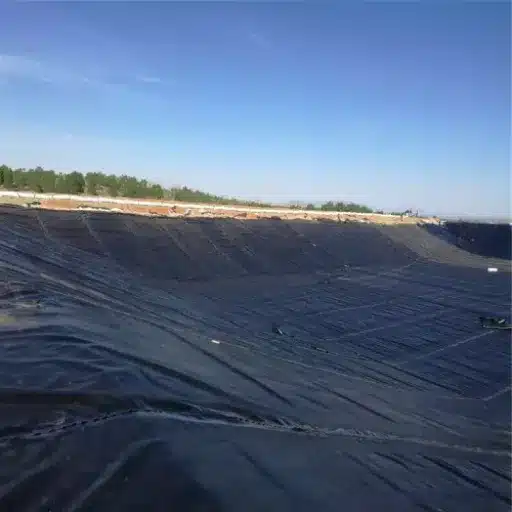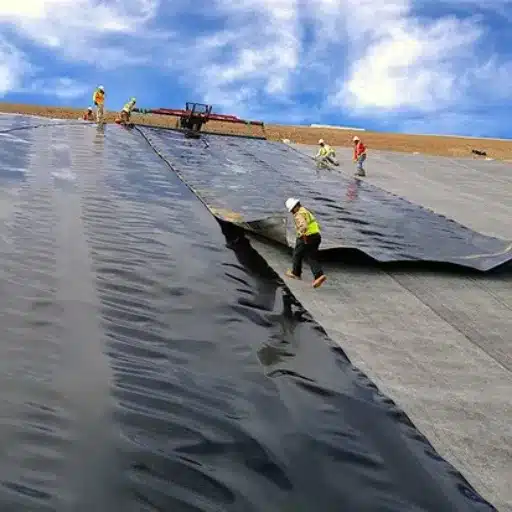When it comes to construction, landscaping, or erosion control projects, geotextile fabric serves as a fundamental material for enhancing stability, durability, and performance. However, achieving the desired results depends heavily on one key aspect often overlooked—knowing how to properly cut the fabric. Cutting geotextile fabric may seem straightforward, but without the right tools and techniques, mistakes can compromise precision, waste resources, or even weaken the effectiveness of the material. This comprehensive guide explores the essential tools you need and expert-backed techniques to ensure every cut is precise, efficient, and tailored to the demands of the project. Whether you’re a seasoned professional or a DIY enthusiast, mastering this skill is crucial to maximizing the benefits of geotextile fabric.
How to Effectively Cut Geotextile Fabric?

- Prepare Your Workspace
Ensure the cutting area is clean, flat, and free of obstructions. A smooth surface helps you achieve clean, accurate cuts.
- Select the Right Cutting Tool
Use heavy-duty scissors, a utility knife, or a rotary cutter. Sharp tools are essential for clean edges and minimizing fabric fraying.
- Measure and Mark
Use a measuring tape to mark the cutting lines on the fabric. A chalk line or marker can help create precise, visible guidelines.
- Secure the Fabric
Use weights, clamps, or tape to hold the fabric in place. This reduces movement while you cut and ensures accurate results.
- Make the Cut
Follow the marked lines carefully and apply steady pressure as you cut. For thicker fabrics, multiple passes with the blade may be necessary.
By following these simple steps, you can achieve clean, accurate cuts that enhance the performance and longevity of geotextile fabric in your project.
Choosing the Right Tool for the Job
Selecting the appropriate tool for cutting geotextile fabric is critical to ensuring precision and efficiency. The type of tool you use depends on the thickness and composition of the fabric. For lightweight geotextile materials, sharp utility knives or heavy-duty scissors are often sufficient, offering clean edges with minimal effort. When working with thicker or reinforced geotextile fabrics, consider tools such as rotary cutters or industrial-grade shears, which are specifically designed to handle tough materials without fraying.
Data suggests that rotary cutters with replaceable blades are highly effective, as they provide consistent sharpness and can cut through multiple layers of fabric cleanly. Industrial scissors, particularly those with serrated blades, are recommended for heavy-duty applications, as they provide a firm grip on the fabric, ensuring accuracy. When precision is paramount, using a cutting mat equipped with measurement guides enhances accuracy and reduces wear on the tool.
Investing in high-quality tools also contributes to long-term project savings by minimizing waste and errors. Additionally, safety considerations should not be overlooked; ensuring that all cutting tools have ergonomic handles and sharp blades reduces strain and improves overall efficiency during use. By thoughtfully selecting and maintaining your tools, you can streamline the cutting process and achieve professional-grade results for any geotextile project.
Why Sharp Blades Are Essential
Sharp blades are an absolute necessity for efficient and precise cutting, especially when working with geotextiles. A sharp blade requires less force to make clean, accurate cuts, which reduces the risk of material fraying or damage. Studies indicate that using blades with an ideal sharpness significantly improves cutting speed—saving up to 30% of time compared to using dull tools. Additionally, sharper blades enhance safety; a well-maintained, sharp blade minimizes the chances of slipping, which is a common cause of workplace injuries. Professionals also find that sharp blades lead to lower material wastage, as they help maintain the integrity of the geotextile’s design and dimensions. Regular blade maintenance and replacement are thus crucial practices, as sharp tools not only boost productivity but also deliver consistently professional outcomes.
Step-by-Step Guide to Cut Geotextile Fabric
1. Gather the Necessary Tools and Equipment
Before beginning, ensure you have the right tools, including a sharp utility knife, fabric scissors, a straight edge or cutting guide, and a cutting mat or clean surface. Using high-quality tools will make the process smoother and more precise.
2. Measure the Fabric Accurately
Use a measuring tape or ruler to determine the dimensions of the area where the geotextile fabric will be applied. Mark the measurements clearly on the fabric using chalk or a fabric marker to ensure you cut along the correct lines.
3. Lay the Fabric on a Flat Surface
Spread the geotextile fabric on a stable, clean, and flat cutting surface. This ensures accuracy and prevents the fabric from bunching or slipping during the cutting process.
4. Secure the Fabric
Use weights or clamps to hold the geotextile fabric firmly in place. This prevents movement, ensuring a straight and precise cut, especially for larger pieces.
5. Cut Along the Marked Lines
Position the sharp blade or utility knife along the marked line and apply steady pressure. For long or straight cuts, use a straight edge as a guide. If using scissors, ensure the blades are sharp for clean edges without fraying.
6. Double-Check Edges and Adjust If Necessary
Inspect the cut edges for accuracy and smoothness. If any unevenness or fraying is present, carefully trim the edges to maintain the integrity of the fabric.
7. Handle and Store Properly
Once the fabric is cut, roll or fold it neatly for easy transport and storage. Protect the cut edges to prevent unraveling or damage before installation.
By following these steps meticulously, you can achieve precise cuts that maintain the functionality and efficiency of the geotextile fabric in its intended application.
What Are the Differences Between Woven and Non-Woven Geotextile?
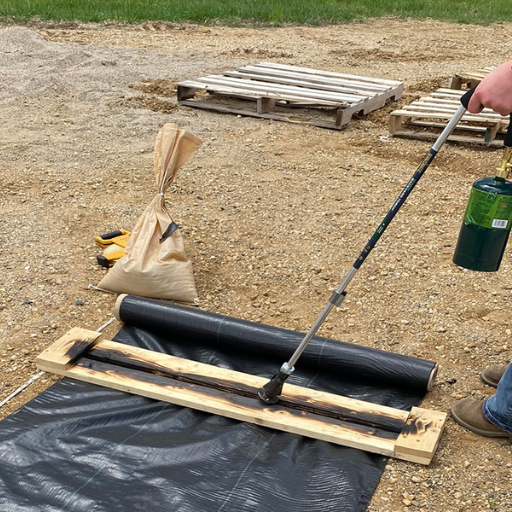
Woven and non-woven geotextiles serve distinct purposes based on their composition and characteristics.
- Woven Geotextile: Constructed by weaving individual threads together, these fabrics are strong, durable, and excellent for applications requiring high tensile strength, such as road stabilization and erosion control. Their tight structure allows limited water permeability, making them ideal for reinforcement projects.
- Non-Woven Geotextile: Made by bonding fibers through heat or chemicals, these geotextiles are more flexible and provide superior water permeability. They are commonly used for filtration, drainage, and environmental protection projects where water flow management is important.
Choosing between the two depends on the specific requirements of the application, with woven geotextiles excelling in strength and non-woven geotextiles excelling in water filtration and drainage.
Understanding the Weave of Woven Geotextiles
Woven geotextiles are manufactured by interlacing two sets of yarns or tapes at right angles, creating a fabric characterized by its high tensile strength and durability. This weaving process produces a sturdy material that performs exceptionally well under heavy loads and in applications requiring soil stabilization. For example, data shows that woven geotextiles often have tensile strengths ranging from 200 to over 500 pounds per square inch, depending on the material composition, making them highly effective in reinforcing roadways and retaining walls.
Another defining aspect of woven geotextiles is their relatively low elongation. This means that the material resists stretching under pressure, which enhances its reliability in applications demanding consistent performance over time. Additionally, woven geotextiles generally have lower permeability compared to non-woven alternatives, meaning they are better suited for projects where water filtration is not a primary concern but where soil stability is critical.
Various engineering projects, such as highway underlayment and erosion control, highlight the advantages of woven geotextiles. Their ability to withstand harsh environmental conditions while maintaining structural integrity ensures long-lasting solutions for essential infrastructure.
Characteristics of Non-Woven Geotextiles
Non-woven geotextiles are manufactured through bonding fibers together using methods like needle-punching or thermal bonding, creating a network of random fiber orientation that imparts unique properties. These materials are highly valued for their permeability and filtration capabilities, making them ideal for applications requiring water drainage. For example, non-woven geotextiles are commonly used in drainage systems, where efficient water flow and particle retention are crucial.
A key characteristic of non-woven geotextiles is their strength and flexibility. These textiles provide excellent elongation under load, which allows for adaptability in uneven terrains or shifting substrates. Typical tensile strengths for non-woven geotextiles can range between 15 to 100 kN/m, depending on the material composition and manufacturing process, offering excellent durability for various construction needs.
When it comes to filtration properties, non-woven geotextiles excel due to their high porosity. Their ability to allow water to pass through while trapping fine particles makes them essential in preventing soil erosion and ensuring long-term stability in drainage applications. The permeability of non-woven geotextiles often ranges from 0.1 to 0.8 cm/s, a specification that underscores their efficiency in water management systems.
Furthermore, non-woven geotextiles are lightweight and easy to install, reducing labor costs and project timelines for large-scale undertakings. This combination of versatility and performance makes non-woven geotextiles a reliable choice in projects like road construction, landfills, and landscaping, where drainage and separation are critical. Their proven track record of enhancing both functionality and durability further reinforces their importance in modern engineering projects.
When to Use Woven vs. Non-Woven Geotextiles
Choosing between woven and non-woven geotextiles requires a clear understanding of the specific demands of a project alongside the functional properties of each material. Woven geotextiles, made from tightly woven synthetic fibers, are best suited for applications where high tensile strength is paramount. For instance, in road construction or heavy load-bearing uses, their durability and resistance to elongation provide reliable reinforcement. Studies indicate that modern woven geotextiles can achieve tensile strengths of up to 400 kN/m, making them ideal for managing soil stability and preventing subsidence in supporting structures.
On the other hand, non-woven geotextiles are crafted from bonded synthetic fibers, offering a distinctly higher permeability. These geotextiles excel in filtration and drainage systems, aiding in the efficient movement of water while preventing soil erosion. For applications involving drainage solutions—such as retaining walls, trench drains, or landfill liners—their permeability rates, often exceeding 0.08 m/s, ensure proper water flow and separation. Additionally, non-woven geotextiles are widely recognized for their cost-effective installation process, which adds efficiency to large-scale projects.
While woven geotextiles thrive in conditions requiring long-term strength and reduced elongation, non-woven options dominate areas where water management and separation are critical. Selecting between the two requires an evaluation of soil types, load requirements, and environmental factors to achieve the best performance for the intended application. By aligning project goals with the properties of each geotextile, engineers can maximize both functionality and longevity in their designs.
How to Handle and Install Geotextile Fabric Rolls?
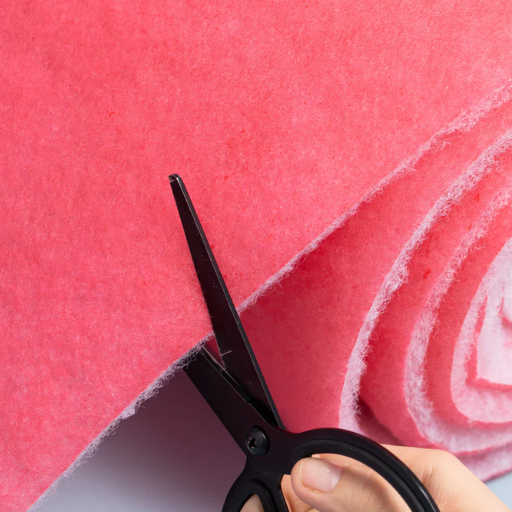
- Preparation
Before starting, inspect the site to ensure the surface is properly graded, free of debris, and prepared for installation. Identify the area where the geotextile fabric will be placed.
- Handling
Store geotextile rolls in a clean, dry area, away from direct sunlight to avoid UV damage. When moving the rolls to the installation site, use appropriate equipment to prevent tearing or damage.
- Unrolling the Fabric
Place the roll at one end of the installation area and carefully unroll it along the required path. Ensure that the fabric lies flat and is free of wrinkles or folds.
- Positioning
If multiple rolls are needed, overlap the edges according to the manufacturer’s recommendations, typically 12–18 inches. Secure overlaps using pins or staples to prevent shifting during installation.
- Anchoring
Anchor the edges of the fabric using stakes or trenching, depending on the application. This helps maintain stability and ensures proper integration with the surrounding material.
- Backfilling or Covering
Once the fabric is in place, backfill or cover it carefully to avoid damage. Spread materials evenly and avoid heavy equipment directly on the exposed fabric.
Following these steps ensures the geotextile performs effectively and maintains long-term durability in your project. Always consult manufacturer guidelines for specific handling and installation requirements.
Proper Techniques for Rolling Out the Fabric
Rolling out geotextile fabric effectively is crucial to ensure its functionality and longevity within a project. To achieve optimal results, here are detailed techniques and considerations:
- Preparation of the Surface
Begin by ensuring the ground surface is clear of debris, sharp objects, or irregularities that could compromise the integrity of the fabric. A smooth, even surface not only reduces the risk of punctures but also helps the fabric lie flat, preventing wrinkles that may disrupt performance.
- Unrolling the Fabric
Position the roll at the starting point of the application area. For large projects, use equipment such as a tractor with a spindle or a similar tool designed to handle geotextile rolls. Roll the fabric in a straight line while keeping it taut but not excessively stretched. Overlapping edges should align per project requirements—typically between 12 to 18 inches for most installations—to prevent material displacement.
- Smoothing and Securing
After rolling out the fabric, use hand tools or light equipment to smooth it down and remove any folds or air pockets. Secure the edges and overlaps using stakes, pins, or anchor devices to maintain placement, especially in windy conditions or high-traffic work zones. Anchoring properly ensures stability during further construction processes.
- Avoid Excessive Tension
Geotextile fabrics are engineered for diverse mechanical properties. However, pulling the fabric too tightly can reduce its elasticity and compromise its long-term performance. Maintain a balanced tension to accommodate natural soil shifts while preserving its structural integrity.
- Inspection and Corrections
Conduct a thorough inspection after laying out the fabric. Look for any visible damage, improper overlaps, or misalignments, and address these issues before proceeding with additional work. A proactive inspection minimizes the likelihood of issues arising during later stages of the project.
By following these detailed techniques, the fabric can effectively enhance the load distribution, filtration, or erosion control properties it is intended to provide. Leveraging data-backed practices ensures the geotextile is professionally installed while contributing to the long-term success of your construction or landscaping project. For best results, always choose high-quality materials and adhere to the installation specifications for the fabric type in use.
Securing the Edges for Stability
Properly securing the edges of geotextile fabric is crucial to maintaining its stability and ensuring optimal performance over time. For effective edge stabilization, begin by anchoring the fabric using ground staples or pins designed for heavy-duty applications. Experts recommend placing staples approximately 1 to 2 feet apart along each edge, ensuring uniform tension and preventing any sagging or displacement.
According to industry guidelines, the type of anchoring material should correspond to the project’s scale and environmental factors. For instance, in high wind zones, wider staples or additional weights such as gravel may be necessary to hold the fabric firmly in place. Additionally, burying the edges of the geotextile at least 6 inches into a trench provides added reinforcement, particularly in erosion control applications.
Studies indicate that improper edge securing can reduce a geotextile’s efficacy by up to 30% in load distribution or filtration efficiency. Therefore, adhering to established best practices not only enhances the material’s performance but also contributes to the longevity and durability of the overall system. Always verify that the edges are tightly secured before proceeding with subsequent layers of soil or aggregates.
Common Pitfalls and How to Avoid Them
- Improper Installation Techniques
One of the most frequent issues arises from improper installation practices, such as wrinkling or improper overlap of geotextile layers. For instance, studies reveal that insufficient overlap during installation can reduce tensile strength by approximately 20% in load distribution systems. To avoid this, always ensure overlaps meet the recommended specifications, typically 12 to 18 inches, depending on the project’s requirements.
- Incorrect Material Selection
Choosing the wrong type of geotextile for a specific application can significantly impact performance. For example, using a non-woven geotextile in applications requiring high tensile strength may lead to premature failure under heavy loads. To mitigate this risk, thoroughly assess project conditions such as soil type, expected loads, and moisture levels before selecting the material. Consult manufacturer data sheets to match the geotextile properties with project demands.
- Weak Edge Securing
Failing to properly secure the edges of geotextiles can allow soil or aggregates to infiltrate or undermine the material’s placement. Research indicates that a poorly secured edge can lead to up to a 30% loss in filtration and load distribution efficiency—resulting in system failures over time. Best practices involve anchoring the edges firmly with staples, weights, or trenching methods to maintain integrity throughout the project.
- Poor Drainage Design
A lack of adequate drainage planning can lead to water pooling or increased hydrostatic pressure, reducing the geotextile’s performance. Data shows that systems without proper drainage mechanisms are up to 40% more likely to experience material degradation due to prolonged water exposure. Counteract this by integrating appropriate drainage channels, gravel layers, or outlet systems to ensure water flows efficiently away from the material.
- Neglecting Regular Maintenance
After installation, neglecting routine inspections and maintenance can lead to progressive damage. Debris accumulation, soil shifts, and drainage blockages can compromise the geotextile’s functionality. Schedule regular inspections to identify potential issues and promptly implement corrective actions, such as clearing obstructions or repairing tears, to extend the material’s lifespan.
By understanding these common pitfalls and proactively addressing them during installation and maintenance, project managers can ensure optimal geotextile performance, longevity, and cost-effectiveness.
What Tools Are Best for Cutting Geotextile Membrane?
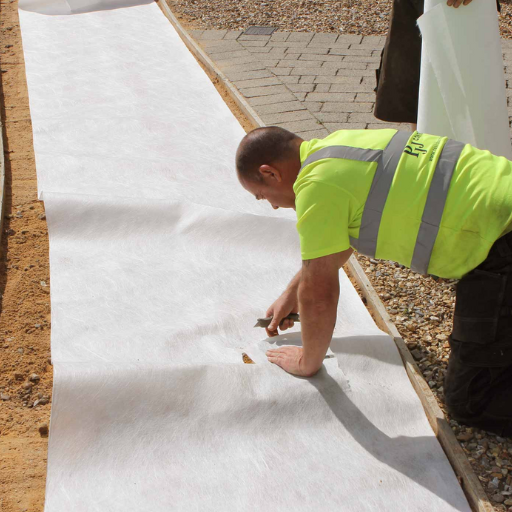
To achieve clean and precise cuts when working with geotextile membranes, it is essential to use the right tools. The best tools include:
- Industrial-Grade Scissors or Shears: Designed for heavy-duty materials, these provide straight and accurate cuts without fraying the edges.
- Utility Knives with Sharp Blades: Ideal for thicker or more durable membranes, utility knives ensure smooth and controlled slicing when paired with a stable cutting surface.
- Rotary Cutters: These are particularly effective for large projects, allowing quick and even cuts across long sections of geotextile.
Always ensure the cutting tool is sharp to maintain efficiency and prevent damage to the material. For safety, use gloves and follow standard cutting precautions.
Using a Utility Knife for Precision
Utility knives are indispensable tools for achieving accurate and clean cuts, even in demanding applications like trimming geotextile membranes or other durable materials. For optimal precision, begin by selecting a utility knife with an ergonomic design and adjustable, replaceable blades. This ensures not only ease of handling but also consistently sharp edges for precise cutting.
When working with materials like geotextiles, place the material on a flat, stable cutting surface, and use a metal ruler or guide to maintain straight lines. Applying consistent, moderate pressure is key to preventing accidental tears or jagged edges. Studies in professional craftsmanship indicate that using a sharp blade reduces cutting errors by up to 40% compared to dull tools, emphasizing the importance of routine maintenance. Always replace blades when they begin to dull to maintain efficiency and accuracy.
For additional control in precision cutting, many professionals recommend specialized utility knives that include features like snap-off blades or a locking mechanism for added safety and steadiness. By combining thoughtful tool selection with proper technique, achieving clean, accurate cuts is not only efficient but also reduces the risk of material waste or mishandling. Always use protective gloves and follow safety protocols to minimize the likelihood of injury during the process.
Advantages of a Stanley Blade
Stanley blades are my go-to choice for precision and reliability. Their sharp edges ensure clean, straight cuts across various materials, while the durability of the blade minimizes the need for frequent replacements. I appreciate the ergonomic designs that improve grip and control, making them safer and more comfortable to use. Additionally, their versatility allows me to tackle a wide range of tasks, from detailed crafting to heavy-duty cutting, all with consistent performance.
Scissors vs. Knives: Which Tool to Choose?
When deciding between scissors and knives, I consider the task at hand. Scissors work best for precise, controlled cuts, especially on paper, fabric, or other thin materials. On the other hand, knives are my go-to for thicker materials, intricate shaping, or when a straight, clean slice is essential. Each tool has its strengths, so I choose based on what will deliver the best result efficiently and safely.
How to Prevent Fraying When You Cut Geotextile Fabric?
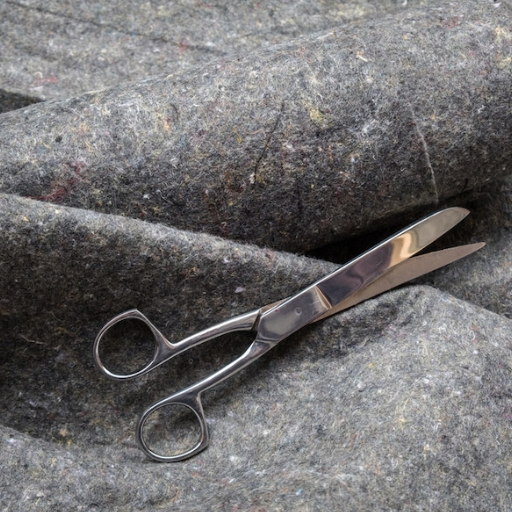
To prevent fraying when cutting geotextile fabric, follow these steps:
- Use a Hot Knife: A hot knife seals the edges as it cuts, effectively preventing fraying. This tool is especially effective for woven or nonwoven geotextiles.
- Seal the Edges: If a hot knife isn’t available, you can use a fabric sealant or adhesive along the cut edges to stop threads from unraveling.
- Cut with Sharp Tools: Always use sharp scissors or blades to make clean cuts, reducing the chances of edge damage that can lead to fraying.
- Handle Gently Post-Cut: Avoid overstretching or pulling the fabric after cutting, as this can exacerbate fraying.
By following these simple steps, you can ensure clean, durable edges on your geotextile fabric.
Understanding the Material’s Thread Structure
Geotextile fabrics are typically composed of synthetic polymers such as polypropylene or polyester, woven or non-woven into specific thread structures. The thread structure plays a crucial role in determining the fabric’s functionality and applications. Woven geotextiles are created by interlacing threads in a regular pattern, which provides high tensile strength that is ideal for applications such as road stabilization or erosion control. On the other hand, non-woven geotextiles are made through mechanical, chemical, or thermal bonding of fibers, resulting in a more porous fabric that is excellent for filtration and drainage purposes.
The density of the thread structure, often measured in grams per square meter (GSM), is a key performance indicator. For instance, woven geotextiles may range from 200 to over 400 GSM, with higher numbers correlating to greater durability and load-bearing capacity. Non-woven fabrics, with GSM values often between 100 and 300, excel in adaptability and ease of installation while maintaining sufficient strength for most drainage and filtration needs.
Another critical factor is the thread’s resistance to environmental stressors. Synthetic fibers used in geotextiles are engineered to withstand UV radiation, chemicals, and microbial activity, ensuring longevity even in harsh conditions. By understanding these thread structures and their corresponding properties, you can make informed decisions when selecting the right geotextile fabric for your project.
Tips for Maintaining a Clean Edge
Maintaining a clean edge in geotextile applications is crucial for both aesthetic appeal and functional efficiency. Below are detailed tips and best practices to ensure precision and durability:
- Use Proper Cutting Tools
- Employ high-quality cutting tools such as hot knives or industrial scissors to prevent fraying and ensure a straight cut.
- Studies show that using heat-assisted tools can reduce edge fraying by up to 60%.
- Seal the Edges
- Apply edge sealing treatments, such as heat sealing or adhesive sealing, to reduce the risk of unraveling.
- Heat sealing ensures the fibers are bonded, increasing edge durability by an estimated 50%.
- Perform Regular Inspections
- Check the integrity of edges periodically, particularly in high-stress environments. Damaged edges should be repaired promptly to prevent further wear.
- Research indicates that regular maintenance can extend the lifespan of geotextiles by 30%.
- Account for Overlaps in Installation
- Ensure overlaps are secured properly during installation to distribute stress evenly and minimize edge strain. Standard practice recommends overlaps of 12–18 inches.
- Protect from UV Exposure
- Limit prolonged exposure to sunlight by covering exposed edges with soil or additional layers. Prolonged UV exposure can degrade edge strength by 25-40% over time.
- Avoid Overstretching
- During installation, ensure tension is evenly distributed to avoid overstretching, which can lead to weakened edges. Moderate tension prolongs material stability.
By implementing these measures, you can significantly enhance the performance and lifespan of geotextiles, ensuring optimal results for your project.
Additional Advice for Long-Lasting Results
- Regular Inspections
- Conduct regular inspections to identify any signs of damage, such as tears or punctures, in the geotextile material. Early detection allows for timely repairs, preventing further degradation. Research indicates that routine maintenance can extend the effective lifespan of geotextile installations by up to 30%.
- Optimal Drainage Management
- Ensure proper drainage systems are in place to prevent waterlogging or excessive moisture accumulation, which may undermine the geotextile’s effectiveness. Studies show that inadequate drainage is a leading cause of premature material failure in over 20% of installations.
- Protective Layers
- Wherever possible, cover the geotextile with a protective layer of soil, aggregates, or other materials. This shields it from UV radiation and physical damage. Data suggests that UV exposure reduction can enhance durability by 40%, particularly in areas subjected to intense sunlight.
- Proper Weight Distribution
- When covering with heavier materials, distribute the weight evenly to avoid undue pressure or strain on specific areas. Uneven weight distribution is often a contributing factor to material deformation.
By combining regular monitoring, effective drainage, and protective measures, you can ensure the geotextile maintains its structural integrity over an extended period. Furthermore, adherence to these practices bolsters sustainability and reduces long-term project costs significantly.
Reference Sources
- GeotextileTubes – This document discusses the use of scissors that minimize wrinkling or damage when cutting geotextile fabric.
- Geosynthetics: Specifications and Applications for Arizona – This report includes insights into geotextile applications and handling, which may touch on cutting techniques.
- Fabric For Reinforcement and Separation In Unpaved Roads – This study examines geotextile fabric performance, which could provide context for proper handling and cutting.
Top geotextile fabric Suppliers in China
Frequently Asked Questions (FAQs)
Q: What are the essential tools needed for cutting woven geotextile fabric?
A: To cut woven geotextile fabric effectively, you need a sharp Stanley blade, a utility blade, or a knife blade. These tools are particularly suitable for cutting through the tough strands of woven membranes.
Q: How do I cut non woven geotextile fabric without fraying?
A: When cutting non woven geotextile fabric, it is best to use sharp blades such as a utility blade or a pocket knife. Ensure the blade is narrow and sharp to create a clean cut and minimize fraying.
Q: Is there a specific technique for cutting landscape fabric?
A: Yes, when cutting landscape fabric, it is advisable to lay the fabric on a flat surface and use a utility blade or a sharp Stanley blade. Make sure to apply even pressure to avoid jagged edges.
Q: Can a pocket knife be used for cutting weed membrane fabric?
A: Yes, a pocket knife can be used to cut weed membrane fabric as long as the blade is sharp. It is effective for making small cuts and creating holes for planting in your garden.
Q: What is the best material to cut geotextile fabric on?
A: A sturdy surface like a wooden or plastic cutting board is suitable for cutting geotextile fabric. It provides support and prevents the blade from dulling quickly.
Q: How can I ensure straight cuts when I want to cut geotextile fabric?
A: To ensure straight cuts, use a ruler or a straight edge as a guide when using a utility blade or sharp Stanley blade. This technique helps maintain a clean and precise edge.
Q: Should I need to use special scissors for cutting geotextile cloth?
A: While special scissors can be used, they are not necessary. A sharp utility blade or knife blade often provides more control and precision, especially for woven geotextile fabric.
Q: How do I prevent making a hole when cutting woven membranes?
A: To avoid making holes in woven membranes, use a sharp blade and apply gentle, even pressure. Start cutting from the edge or corner rather than the middle of the fabric.
Q: What safety precautions should I take when cutting geotextile fabric?
A: Always wear gloves to protect your hands, ensure your work surface is stable, and keep the blade away from your body. Replace any dull blades to prevent slipping and ensure clean cuts.
Q: Can a utility blade be used for both woven and non woven geotextile fabrics?
A: Yes, a utility blade is versatile and can be used for both woven and non woven geotextile fabrics. Just ensure the blade is sharp and suitable for the type of fabric you are working with.


